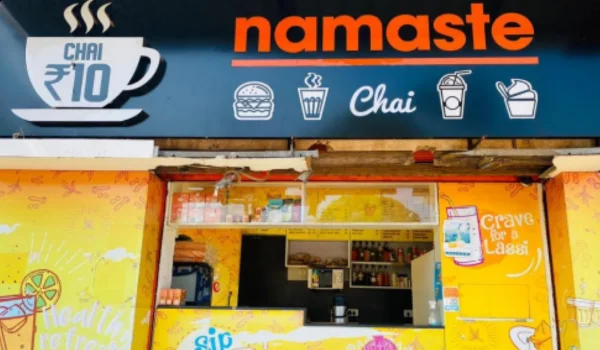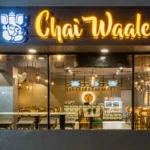Namaste Chai began operations in 2018 and has quickly expanded with over 50 outlets and millions of cups sold, positioning itself as a premium chai brand focused on quality and repeatability. According to its official site, the brand promotes low investment (₹8 lakh onwards), high profit margins (up to 65%), simple operations, and zero waste with professional support systems for franchisees.
💰 Investment & Financial Overview
Investment Snapshot
| Component | Estimate (₹ lakh) |
| Space Required | 80–200 sq.ft |
| Franchise Fee | ₹0.1 lakh (₹10,000) |
| Initial Setup & Inventory | ₹8 lakh onwards |
| Royalty / Commission | 50% of net sales |
| Expected Profit Margin | Up to 65% |
| Likely Payback Deployment | 0–0 months claimed |
- FranchiseIndia lists initial investment as low as ₹10,000 to ₹50,000 with one-time brand fee ₹100 and a 50% revenue share in favour of the franchisor.
- Despite such low capex claims, royalty at a full 50% drastically reduces profitability. A nominal investment does not automatically translate to low risk.
🏗 Business Model & Support Framework

Franchise Format
- Micro‑kiosk or counter model optimized for minimal space (80–200 sq.ft) and light tea‑only operations.
- FOFO format (Franchise Owned, Franchise Operated), with franchisee responsible for daily operations; brand provides basic SOPs, supply guidance, and banner support.
Brand Support
- Provision of basic brand collateral, startup kits, and marketing templates.
- Limited claims of training, site selection, ongoing audits or supply-chain support appear to be notably absent in official sources.
- Given the extremely low entry cost and high revenue share, structured hand-holding is likely minimal.
📈 Revenue, Margins & ROI Realities
Profitability at a Glance
While margins up to 65% gross are claimed, with 50% royalty, net profitability is modest at best unless volume is high:
- Suppose daily sales ₹3,000 (≈300 cups at ₹10 each), monthly ₹90,000.
- Royalties at 50% consume ₹45,000, leaving ₹45,000 gross.
- Operating costs (materiel, rent, staff) at ~30–40% could reduce net profit to ₹20–25K → ≤ 30% net margin overall—much lower than suggested.
Claimed ROI & Reality Check
- FranchiseIndia reports 0–0 month payback, based on minimal capex but ignores cash flow sustainability.
- With half the revenue going to royalties, sustainable profitability requires disciplined cost control and sustained footfall—rare in micro‑kiosk setups.
- Realistic ROI is likely 6–12 months, and only under optimal conditions; otherwise ROI may stretch to 12–24 months—still not attractive given high revenue share.
✅ Eligibility Criteria & Ideal Profile
Who Should Consider?
- Capital availability: ₹0.1–0.5 lakh sufficient for fee; but planning for at least ₹8–10 lakh investment is prudent for setup, stock and operational buffer.
- Space: 80–200 sq.ft kiosk in high footfall areas—malls, campuses, railway stations.
- Operational mindset: Willing to run a small, high-turnover outlet; manage staffing and inventory diligently.
- Documentation readiness: PAN, Aadhaar, GST, trade license, permissions for kiosks.
- Long-term orientation: Accept up to 50% revenue share while aligning to micro‑franchise format.
📝 How to Apply – Step-by-Step
- Submit Inquiry
Fill franchise application form via Namaste Chai website or FranchiseIndia listing to initiate contact. - Initial Screening
Franchise team evaluates location, capital, and business readiness. - Agreement Signing
Minimal paperwork; pay ₹10K franchise fee and agree to revenue‑share terms. - Setup & Supply
Set up kiosk or counter; order starter kit—brand signage, packaging, raw chai supply. - Go Live & Operations
Commence sales immediately. Since payback is nominal, manage margins carefully due to 50% commission. - Track & Review
Monitor daily sales, control costs, ensure repeatability and brand standards.
⚖️ Advantages vs Risks
✅ Positives
- Extremely low upfront investment makes it accessible.
- Quick setup time—kiosk format suited for lean entry.
- Potential for fast break-even, albeit with razor-thin margins.
- Brand recall and minimal infrastructure reduce complexity.
❌ Major Concerns
- 50% commission on net sales undermines profitability unless sales volume is high.
- Claimed margins of up to 65% may be misleading without context of royalty.
- Limited franchisor support implied; training and operations help appear very basic.
- Scaling risk: small format may struggle with consistency and footfall.
- Reddit / industry cautions repeatedly warn that high-margin franchises often fail without strong backup capital and robust location selection (see Reddit debate on F&B franchising risk).
💡 Expert Recommendations
- Visit existing Namaste Chai units to observe customer flow and operational quality.
- Crunch real-world financials: document volume, cost, expected royalty payout, and likely net profit.
- Talk to existing franchisees: Ask about support, logistics, franchise experience and actual ROI.
- Location matters above all: Only high-traffic corridors justify 50% revenue share.
- Plan for buffer capital: Maintain working capital for 3–6 months in lean periods.
- Negotiate exit/transfer terms—some brands may not allow early breakup or transfer.
🧾 Franchisee Quick Summary
- Capital Required: ₹0.1 lakh for fee; realistically ₹8–10 L for setup.
- Space: 80–200 sq.ft.
- Franchise Fee: ₹10,000.
- Royalty: 50% of net sales.
- Profit Margin: Realistic net ≤ 30% after cost and royalty.
- Payback: Likely 6–12 months with strong volume.
- Term: Typically indefinite or default contract, check details.
- Licences: GST, trade licence, permissions for kiosk.
🎯 Final Verdict
Namaste Chai presents a low-barrier entry into chai franchising with minimal upfront cost. However, the 50% revenue commission model dramatically compresses profitability, shifting risk to the operator in a thin-margin business.
If you plan to go ahead, you must ensure:
- A prime location with consistent demand,
- Rigid cost control and disciplined operations,
- Realistic expectations on margins and revenue split.

Shashi Kant is the Founder and Editor of BusinessScroller.com, a leading platform for business insights, finance trends, and industry analysis. With a passion for journalism and expertise in business reporting, he curates well-researched content on market strategies, startups, and corporate success stories. His vision is to provide valuable information that empowers entrepreneurs and professionals. Under his leadership, BusinessScroller.com has grown into a trusted source for in-depth articles, customer care guides, and financial expertise.


